From pv magazine USA
Grid-forming inverters “are going to be needed once we get to very high levels of inverter-based resources,” said Ben Kroposki, organizational director of the UNIFI Consortium and director of the National Renewable Energy Laboratory’s Power Systems Engineering Center, at an RE+ conference panel discussion in September.
Solar, wind and storage resources are all inverter-based.
For 120 years, Kroposki explained, the electric grid has been based on synchronous generators, which can create the 60 hertz frequency used on the US grid to “black start” the grid after a complete blackout. Synchronous generators also synchronize to the existing frequency and provide other key functionality.
Most inverter-based resources installed to date use grid-following inverters. In the event that a large amount of generation goes offline, causing the frequency to fall below 60 hertz, generators that use grid-following inverters “try to keep online and inject power and keep the frequency stable,” Kroposki said. He referred to the solid red line in the graph above showing the modeled performance of a grid in which 73% of the generation uses grid-following inverters, following a sudden loss of generation.
The problem under that scenario, Kroposki said, is that the frequency drops below 59.5 hertz, shown with the dashed red line, in which case “the way to save the system is to drop some load,” resulting in a partial blackout, “and keep the rest of the system online.”
Grid-forming inverters, in contrast, can respond much more quickly to a frequency disturbance to maintain the frequency within range, Kroposki said, as shown by the green line in the graph. This capability is known as fast frequency response.
These modeling results were obtained by the Western Electricity Coordinating Council’s modeling and validation subcommittee.
The Texas grid operator ERCOT already occasionally reaches 71% instantaneous inverter-based generation, Kroposki said, which is very close to the 73% modeled in the scenario he described.
Some island grids are already past 73% instantaneous inverter-based generation, Kroposki said, including the Hawaiian Islands of Kauai and Maui, and Ireland.
Joining Kroposki in the panel discussion, Becca Jones-Albertus, director of the US Department of Energy’s Solar Energy Technologies Office, said that an annual renewable generation percentage of 60% to 80% on a grid implies instantaneous generation of nearly 100% for the inverter-based resources.
Hawaii already requires grid-forming inverters for their large-scale energy storage projects, Kroposki said. He described a project on the big island of Hawaii in which the National Renewable Energy Laboratory (NREL) is evaluating the performance of two grid-forming inverters made by different manufacturers, each with a capacity of at least 10 MW, working together on the island power system.
NREL is also rotating grid-forming inverters from different manufacturers through a 1 MW testing facility to ensure that they can all work together.
That type of technology validation is one key function of the UNIFI Consortium, while another is providing industry standards for grid-forming inverters. Consortium members are working to ensure that grid-forming inverters can provide voltage stability and regulation, damp oscillations, black start the grid, and provide cybersecurity.
The consortium is focused on helping commercialize grid-forming inverters, which are already available for battery storage. Grid-forming inverters for PV-only and wind-only projects are “about to hit the commercial market probably this year or next year,” Kroposki said.
Kroposki said the consortium offers a seminar series and other educational materials through its website.
UNIFI is an approximate acronym for Universal Interoperability for Grid-Forming Inverters. The US Department of Energy funds the consortium, which was formed last year.
This content is protected by copyright and may not be reused. If you want to cooperate with us and would like to reuse some of our content, please contact: editors@pv-magazine.com.



What’s the problem with just employing large synchronous reactors?